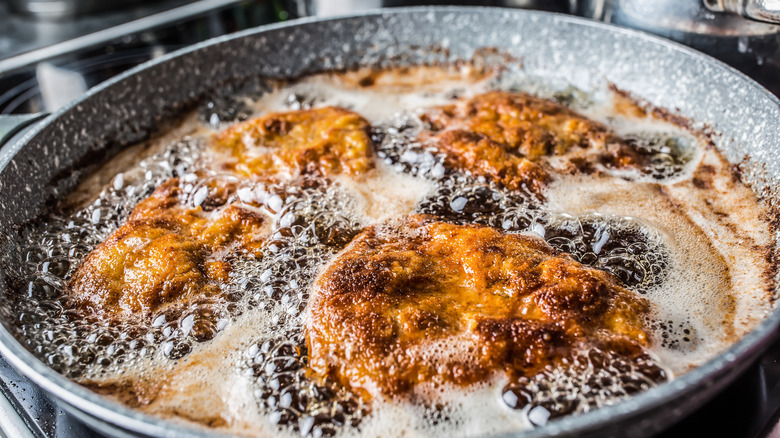Your Chicken Schnitzel Isn't Perfect Unless The Breading Does This
Breaded chicken comes in all different forms across the world, but there is something special about chicken schnitzel. Originating in Vienna, Austria, schnitzel is a distinct style of chicken cutlet that on the surface looks almost identical to Italian Milanese or Japanese katsu, both delicious options of their own. Yet we all know that exterior appearances can be deceiving; it's what's inside that counts, and chicken schnitzel often manages to achieve a surprisingly light crust with a tender interior that can be far more juicy than most breaded chicken. That comes from a few factors, including the style of breading and how the cutlets are fried, but the surefire sign you need to see when making chicken schnitzel is a breading that puffs up and away from the meat as it cooks.
Unlike almost any other style of fried chicken cutlet, you don't want the coating to cling to the surface of the meat as you cook. The thinly sliced chicken should be completely enveloped by a solid exterior crust, which gets wrinkly and folded from the puffing action during frying. That famously light crust means your schnitzel was made with the proper breading, and that it was cooked with the right amount of heat to keep it juicy. Without it, you may still have fried chicken, but you won't have schnitzel.
Your breading puffing up and separating from the chicken is the sign of great schnitzel
What makes the puffing on schnitzel so important? It has to do with insulating the chicken from the high heat of the oil. The puffing is caused by creating a breading that is solid enough to trap steam inside the schnitzel. The steam causes the puffing, which creates an airy space separating the chicken from the hot oil outside. The chicken cooks more gently and stays tender inside the puff, while the crust cooks quickly in the oil, leading to the perfect contrast between crispy breading and moist meat.
To ensure that perfect puff for your schnitzel, you need to get each element right. Your chicken should be pounded thin and smooth, as ridges in your meat can encourage clinging. Your breadcrumbs should be very fine, not panko, as you need to minimize gaps in the crust. A thin, light breading is a key feature of schnitzel. Finally, there are two things to watch for as you cook. You need to fry your schnitzel as soon as it's breaded, because the crumbs will start soaking up egg and weighing down the crust. And you need to use enough oil to fully submerge your schnitzel while keeping it away from the bottom of your pan, as uneven heat can inhibit the puffing. It's a delicate, demanding operation, but one that turns out the gold standard in chicken cutlets.

